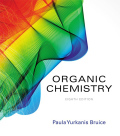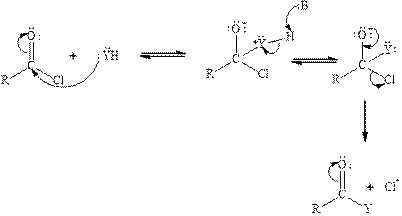
Concept explainers
(a)
Interpretation:
To predict the compound formed by the reaction of phosgene with given compound.
Concept introduction:
Carbonyl carbon of phosgene is highly polar in nature because of the presence of electronegative groups attached to it. So phosgene will undergo nucleophilic addition-eliminationreaction. Tetrahedral intermediate is formed when nucleophile is added to the carbonyl carbon of phosgene. The tetrahedral intermediate is unstable therefore chloride ion gets eliminated. The acyl chloride reacts with neutral nucleophile by the following mechanism:

(b)
Interpretation:
To predict the compound formed by the reaction of phosgene with given compound.
Concept introduction:
Carbonyl carbon of phosgene is highly polar in nature because of the presence of electronegative groups attached to it. So phosgene will undergo nucleophilic addition-eliminationreaction. Tetrahedral intermediate is formed when nucleophile is added to the carbonyl carbon of phosgene. The tetrahedral intermediate is unstable therefore chloride ion gets eliminated. The acyl chloride reacts with neutral nucleophile by the following mechanism:

(c)
Interpretation:
To predict the compound formed by the reaction of phosgene with given compound.
Concept introduction:
Carbonyl carbon of phosgene is highly polar in nature because of the presence of electronegative groups attached to it. So phosgene will undergo nucleophilic addition-eliminationreaction. Tetrahedral intermediate is formed when nucleophile is added to the carbonyl carbon of phosgene. The tetrahedral intermediate is unstable therefore chloride ion gets eliminated. The acyl chloride reacts with neutral nucleophile by the following mechanism:

(d)
Interpretation:
To predict the compound formed by the reaction of phosgene with given compound.
Concept introduction:
Carbonyl carbon of phosgene is highly polar in nature because of the presence of electronegative groups attached to it. So phosgene will undergo nucleophilic addition-eliminationreaction. Tetrahedral intermediate is formed when nucleophile is added to the carbonyl carbon of phosgene. The tetrahedral intermediate is unstable therefore chloride ion gets eliminated. The acyl chloride reacts with neutral nucleophile by the following mechanism:

Want to see the full answer?
Check out a sample textbook solution
Chapter 15 Solutions
EBK ORGANIC CHEMISTRY
- When phenol is treated with excess of bromine water, which of the following product it gives? Select one: a. 2-Bromophenol b. 2,4-Dibromophenol c. 2,4,6-Tribromophenol d. 2,3,4-Tribromophenolarrow_forwardWhat process will not yield carboxylic acid?arrow_forwardEsterfication is the reaction of carboxylic acid with Select one: a. water b. alcohol c. alkyl halide d. ammoniaarrow_forward
- Reactions of carbonyl compounds with hydride ion donors. a. Draw reaction of an aldehyde with sodium borohydride forms a primary alcohol. b. Draw reaction of a ketone with sodium borohydride forms a secondary alcohol.arrow_forwardConsider the structure of cyclohexene, if it undergoes epoxidation followed by exposure to water, which of the following final product is formed? a. Cyclohexan-1,2,-diol b. Cyclohexane c. Cyclohexanone d. Hexan-1,-6-dioic acidarrow_forwardWhich could explain the stronger acidity of phenols compared to alcohols. Why? a.pi-electron delocalization b.steric effect c.hydrogen bonding d.hyperconjugationarrow_forward
- Phenol is Select one: a. CH3CH2CH2OH b. C8H11OH c. CH3CH2CH2CH2CH2OH d. C6H5OHarrow_forwardStarting with cyclohexene, how can the following compounds be prepared? a. methoxycyclohexane b. cyclohexylmethylamine c. dicyclohexyl etherarrow_forwardAn aldehyde can be oxidized to produce a carboxylic acid.Draw the carboxylic acid that would be produced by theoxidation of each of the following aldehydes:a. 3-Methylpentanal c. 2,4-Diethylhexanalb. 2,3-Dichlorobutanal d. 2-Methylpropanalarrow_forward
- Which of the following carboxylic acid is toxic when ingested? a.Citric acid b.Malic acid c.Acetic acid d.Oxalic acid What is the general formula for Grignard reagents? a.RCOOH b.RMgX c.RX d.RCOX Oxidation of alkyl benzenes in the presence of Sulfuric acid will produce which carboxylic acid? a.Cyclohexanecarboxylic acid b.Benzoic acid c.Acrylic acid d.Fumaric acid What dicarboxylic acid contains six carbon atoms in its structure? a.Capric acid b.Pimelic acid c.Adipic acid d.Hexanoic acid Which of the following is an example of an unsaturated carboxylic acid? a.Succinic acid b.Formic acid c.Glycolic acid d.Acrylic acidarrow_forwardWhat occurs in this reaction?arrow_forward16. If toluene is synthesized from benzene and methyl chloride, what reaction has been observed? A. Halogenation B. Friedel-Craft's alkylation C. Sulfonation D. Nitrationarrow_forward
 Chemistry & Chemical ReactivityChemistryISBN:9781337399074Author:John C. Kotz, Paul M. Treichel, John Townsend, David TreichelPublisher:Cengage Learning
Chemistry & Chemical ReactivityChemistryISBN:9781337399074Author:John C. Kotz, Paul M. Treichel, John Townsend, David TreichelPublisher:Cengage Learning Organic ChemistryChemistryISBN:9781305580350Author:William H. Brown, Brent L. Iverson, Eric Anslyn, Christopher S. FootePublisher:Cengage LearningChemistry: Matter and ChangeChemistryISBN:9780078746376Author:Dinah Zike, Laurel Dingrando, Nicholas Hainen, Cheryl WistromPublisher:Glencoe/McGraw-Hill School Pub Co
Organic ChemistryChemistryISBN:9781305580350Author:William H. Brown, Brent L. Iverson, Eric Anslyn, Christopher S. FootePublisher:Cengage LearningChemistry: Matter and ChangeChemistryISBN:9780078746376Author:Dinah Zike, Laurel Dingrando, Nicholas Hainen, Cheryl WistromPublisher:Glencoe/McGraw-Hill School Pub Co Chemistry for Today: General, Organic, and Bioche...ChemistryISBN:9781305960060Author:Spencer L. Seager, Michael R. Slabaugh, Maren S. HansenPublisher:Cengage Learning
Chemistry for Today: General, Organic, and Bioche...ChemistryISBN:9781305960060Author:Spencer L. Seager, Michael R. Slabaugh, Maren S. HansenPublisher:Cengage Learning Macroscale and Microscale Organic ExperimentsChemistryISBN:9781305577190Author:Kenneth L. Williamson, Katherine M. MastersPublisher:Brooks Cole
Macroscale and Microscale Organic ExperimentsChemistryISBN:9781305577190Author:Kenneth L. Williamson, Katherine M. MastersPublisher:Brooks Cole




